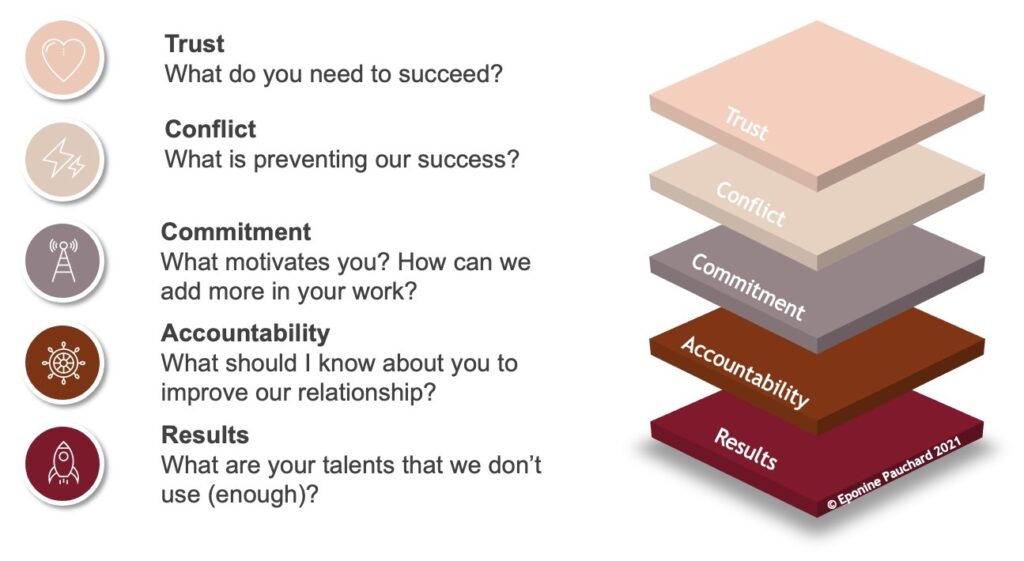Today, I equip you to better understand the key component of performance: emotional safety. All organizations seek to be successful. Many are launching initiatives to ensure they operate to their maximum potential. But too often these initiatives do not address the real problems.

We now know that emotional safety, a concept originally used in psychology for couples, applies particularly well in the corporate world. In this post, I explain what emotional safety consists of and I give you ways to improve your corporate culture, based on the five dysfunctions, formalized more than 20 years ago by Patrick Lenconi.
What is emotional safety?
It’s when I feel safe enough to be myself. I don’t need to create a character for myself or fade my character traits. I do not censor myself, I do not hide certain ideas or thoughts.
This definition simplifies the idea somewhat. Indeed, to function in society, we must alleviate certain character traits. But, in a democratic and tolerant country, I can, to a certain extent, express myself as I am.
Emotional safety is a subjective feeling. Everyone will feel good in different conditions. Current events, and debates around the wearing of masks or vaccinations, remind us that everyone’s needs and limitations are different.
At the other extreme, in a relationship, the same behavior can be seen as invasive or benevolent depending on the individual.
In an organization, it’s the same thing. A manager will be seen as caring and attentive by some, while others will complain about micromanagement.
How do I develop emotional safety in my organization?
Since every individual, every culture has different needs, there is no magic recipe for improving emotional safety. Unlike a new visual identity or compensation program that can be applied at once to the entire organization, emotional safety is highly dependent on the behavior of each individual, whether manager or employee.
Increase trust with vulnerability
To have confidence, I must have the right to be wrong. Indeed, it is in difficult situations that trust is useful. It is in these moments that we discover if our manager is there for us.
If I dare say that I don’t know, that I didn’t succeed, my colleagues can help me. But sharing one’s imperfections and mistakes can only be done in a serene atmosphere.
The question to ask your employees or colleagues: What do you need to succeed? What can I do for you?

Overcoming the fear of confrontation
Too often, ideas are associated with their bearer. In a healthy confrontation, we debate about the ideas, not their carriers. The questions asked aim to understand, dissect, reinforce the idea and not the person.
When I dare to ask the important questions on any subjects, we make sure we make the right decisions. We do not embark for Abilene in an artificial harmony.
The question to ask your employees or colleagues: What prevents us or could prevent us from succeeding?
Strengthen commitment around a common goal
The team knows, understands and adheres to the common goal. Everyone works together to achieve the vision. When the goal is not shared, efforts are less sustained.
There are more insidious situations, especially in non-profit organizations. In these cases, although everyone shares the vision, the action plan or the strategy to implement it is not shared. Without trust and fruitful debate, no one is really implementing the chosen plan.
The question to ask your employees or colleagues: What motivates you, and how can we add more of this to your daily life?
Be accountable for your actions
Each employee takes care of the planned actions as defined in a group. I act according to our planning and correct or adapt the plan to achieve our goals. I dare to question behaviors that I consider unproductive. I explain how my actions will help the team if they are subject to debate. This time, the confrontation is closer to the individuals since it must be done on the action taken.
The question to ask your employees or colleagues: What do I need to know about you to improve our relationship?
Keep an eyeon global results
Finally, each team member keeps an eye on the results. Not his personal results, but those of the team. Everyone has the vision and mission in mind, and adheres to it. I dare to fail on one of my goals, to help others achieve business goals. We see and aim higher. My “sacrifice” is valued, because what matters is the overall performance.
The question to ask your employees or colleagues: What talents, skills or abilities do you have that we do not use or not enough?
What are your next steps?
While the whole thing may seem simple, the implementation remains complex. Ego, personal agendas, and the need for recognition gag the emotional safety of many teams. Altruistic leaders in organizations that balance meaning and profit can infuse this type of culture, one employee at a time.
Rely on the key questions to increase the level of emotional security, and the performance of your organization! One section at a time, look at where you are and if you have any actions to take to improve.

